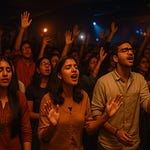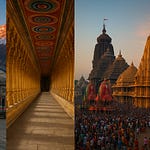The Bhagwan Vitthal Temple located in Palthi village, Parner Taluka, Maharashtra, stands as an important spiritual landmark in the region. This sacred temple is dedicated to Lord Vitthal, a revered incarnation of Lord Vishnu, and holds immense significance for devotees, especially in the Marathi community. Situated amidst the serene landscapes of Maharashtra, the temple carries with it a rich history, deep spiritual importance, and a strong cultural heritage. The temple’s construction, led by the Holkar dynasty under the supervision of Ramji Kamnle Palshi, makes it a historical and architectural marvel, contributing not only to the spiritual but also the cultural fabric of the region.
Origin and Foundation
The Bhagwan Vitthal Temple in Palthi village is rooted in a profound spiritual and historical journey. It was constructed by the Holkar dynasty, which was influential in the Maratha Empire, particularly in central India. The Holkars, known for their patronage of art, culture, and religion, commissioned the temple under the guidance of Ramji Kamnle Palshi.
The foundation of this temple was laid with the intent of providing a place for the worship of Lord Vitthal, an incarnation of Lord Vishnu who holds a special place in the hearts of millions, particularly in Maharashtra and the surrounding regions. Vitthal is known for his ideal qualities of justice, compassion, and protection of devotees. The Holkars, who were deeply devoted to Lord Vitthal, envisioned this temple as a center of divine blessings and cultural vitality for the local community.
History and Architectural Design
The construction of the Bhagwan Vitthal Temple is a significant historical event for Palthi village and the surrounding Parner Taluka. Built during the era of the Holkar dynasty, the temple embodies a blend of traditional Maratha and architectural styles, reflecting the region’s cultural and spiritual heritage. The temple’s structure showcases intricate designs, vibrant sculptures, and exquisite craftsmanship, which were characteristic of the Holkar patronage of the arts.
Over the centuries, the temple has undergone various renovations and expansions, with the aim of preserving its sanctity and ensuring its continued role as a place of worship. Despite these renovations, the essence and spirit of the original Holkar architecture and religious intent have remained intact.
Spiritual Importance
Lord Vitthal, also known as Vithoba or Panduranga, is one of the most revered deities in Maharashtra. He is often depicted standing with his hands on his hips, symbolizing steadfastness, protection, and justice. Devotees believe that Lord Vitthal is the embodiment of divine love and mercy, responding to the sincere prayers of his devotees.
The Bhagwan Vitthal Temple in Palthi serves as a powerful spiritual beacon for the surrounding community. Devotees visit the temple not only to seek blessings for material well-being but also to find spiritual solace and peace. The temple's serene environment and the divine presence of Lord Vitthal make it a place of spiritual healing, introspection, and divine connection.
Rituals and Puja
The temple’s daily rituals are designed to honor Lord Vitthal and create a spiritual atmosphere that allows devotees to connect deeply with the divine. The regular pujas (rituals) performed at the Bhagwan Vitthal Temple are a significant part of its spiritual life. These include:
Morning Aarti and Puja: The temple begins its daily activities with the early morning aarti, where devotees sing hymns and prayers to wake up the deity and seek blessings for the day. This is followed by the regular puja, which involves offerings of flowers, incense, and sacred water.
Evening Aarti: The evening aarti is a major highlight of the temple’s daily rituals. The devotees gather in large numbers to offer their prayers and perform devotional singing, known as bhajans, in honor of Lord Vitthal. The temple’s atmosphere during the evening aarti is especially serene, with the gentle flickering of oil lamps and the chanting of sacred hymns.
Special Puja and Abhishek: During certain festivals or auspicious days, special pujas and the ritual of abhishek (bathing the idol with holy water, milk, honey, and other sacred substances) are performed. These rituals are believed to purify the devotee’s soul and bring blessings for prosperity, peace, and spiritual progress.
Annadhan (Community Feeding): The temple also hosts annadhan (free community meals) on special occasions, which is an important social service in many Indian temples. This ritual reflects the spirit of giving and sharing, both spiritually and materially.
Bhajans and Aarti
Bhajans and aartis are an integral part of the temple’s devotion. Devotees sing bhajans (devotional songs) to express their love and reverence for Lord Vitthal. The temple is known for its vibrant bhajan sessions, especially during festivals like Ashadhi Ekadashi and Kartiki Ekadashi, when large crowds gather to chant and sing in unison.
The aarti sung in honor of Lord Vitthal is a powerful expression of devotion. The popular "Vitthala Vitthala" aarti is sung during the evening worship, drawing the community together in a deep and collective spiritual experience. The rhythm and devotion in the bhajans elevate the devotees' consciousness and create a profound sense of connection with the divine.
Festivals Celebrated
The Bhagwan Vitthal Temple is a hub of celebration during key religious festivals, particularly those that are dedicated to Lord Vitthal. Some of the most important festivals celebrated here include:
Ashadhi Ekadashi: One of the most important festivals in Maharashtra, Ashadhi Ekadashi is celebrated with grand fervor at the Bhagwan Vitthal Temple. Devotees from all over the region, especially from the Warkari tradition, make pilgrimages to the temple to offer prayers to Lord Vitthal and seek his blessings. The temple is adorned with flowers, and special aartis and pujas are held throughout the day.
Kartiki Ekadashi: Another major festival dedicated to Lord Vitthal, Kartiki Ekadashi is celebrated with great devotion. The temple witnesses large gatherings of devotees singing hymns and performing rituals to mark the occasion.
Dattatray Jayanti: Though not directly associated with Lord Vitthal, Dattatray Jayanti is also celebrated with much enthusiasm in the region, and the temple participates in the religious observances.
Vithal Jayanti: This festival marks the birth anniversary of Lord Vitthal and is celebrated with grandeur at the temple. Devotees participate in special prayers, processions, and rituals, offering their prayers to Lord Vitthal for the well-being of their families.
Mystical Significance
While the Bhagwan Vitthal Temple is well-known for its religious rituals and festivals, it is also surrounded by several mystical beliefs. Many devotees believe that Lord Vitthal has the power to heal ailments, provide blessings for prosperity, and even grant liberation (moksha). There are stories of miraculous healings and divine interventions attributed to the deity at this temple, which continue to attract pilgrims from distant regions.
One popular legend in the area is that of Ramji Kamnle Palshi, who is said to have been blessed by Lord Vitthal during his lifetime. His devotion and dedication to the temple are believed to have led to the temple’s construction and continued significance as a sacred space. Some devotees claim to have felt the divine presence of Lord Vitthal in the temple, with some even recounting dreams and visions during their visits.
Visitor Information and Travel Guide
How to Reach:
By Road: The Bhagwan Vitthal Temple is easily accessible by road. Palthi village is well-connected to major towns in Parner Taluka and the surrounding areas.
By Train: The nearest railway station is Ahmednagar, which is approximately 50 km away from the temple. From there, visitors can take a taxi or bus to Palthi village.
By Air: The nearest airport is Pune International Airport, around 140 km away. From the airport, visitors can hire a cab to reach the temple.
Best Time to Visit:
The ideal time to visit the Bhagwan Vitthal Temple is during the winter months (October to February), when the weather is pleasant and conducive for long travels and temple visits. The temple is especially crowded during Ashadhi Ekadashi and Kartiki Ekadashi.
Accommodation: While there are no major hotels directly in Palthi village, there are several accommodations available in nearby towns like Ahmednagar and Shirdi, which are popular pilgrimage destinations in Maharashtra. Visitors can stay in budget hotels, guest houses, or luxurious resorts depending on their preference.
The Bhagwan Vitthal Temple in Palthi village, Parner Taluka, is not just a place of worship but a center of rich spiritual traditions, deep-rooted history, and vibrant cultural practices. The temple, constructed by the Holkar dynasty, is a testament to the Maratha influence on architecture and devotion in Maharashtra. With its rich rituals, vibrant bhajans, divine aura, and the annual festivals that draw thousands of devotees, this temple is a symbol of faith, hope, and divine grace for those who visit it. Whether you are seeking spiritual solace or exploring the cultural heritage of Maharashtra, the Bhagwan Vitthal Temple in Palthi village offers a transformative experience that is bound to stay with you for years to come.










